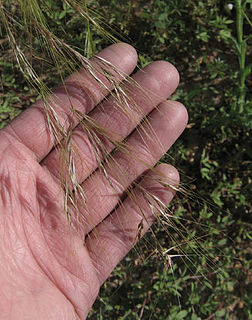
Stipa is a genus of around 300 large perennial hermaphroditic grasses collectively known as feather grass, needle grass, and spear grass. They are placed in the subfamily Pooideae and the tribe Stipeae.
Claudia Pulchra was the name of several women of Roman gens of Claudii during the 1st century BC and 1st century AD. The Latin pulchra is the root of the English word pulchritude.

The MacGregor's honeyeater also known as Macgregor's giant honeyeater, Macgregor's bird of paradise, and ochre-winged honeyeater, is a large black crow-like bird with a large orange-yellow eye-wattles and black-tipped ochre primary wing feathers. The sexes are similar, with the male is slightly larger than female. It is the only member of the genus Macgregoria.

Nassella pulchra, basionym Stipa pulchra, is a species of grass known by the common names purple needlegrass and purple tussockgrass. It is native to the U.S. state of California, where it occurs throughout the coastal hills, valleys, and mountain ranges, as well as the Sacramento Valley and parts of the Sierra Nevada foothills, and Baja California.

The rose-faced parrot is a species of parrot in the family Psittacidae. It is sometimes considered conspecific with the brown-hooded parrot, and was formerly placed in Pionopsitta which is now monotypic. It is found in Colombia and Ecuador.

The beautiful jay is a species of bird in the crow and jay family Corvidae. It is closely related to the azure-hooded jay, and the two species are considered sister species. The species is monotypic, having no subspecies. The specific name for the beautiful jay, pulchra, is derived from the Latin word for beautiful.

Eurydice pulchra, the speckled sea louse, is a species of isopod crustacean found in the northeast Atlantic Ocean.

Nepenthes pulchra is a tropical pitcher plant endemic to the Philippine island of Mindanao, where it grows at 1300–1800 m above sea level. Its discovery was announced online in August 2011.

Tota pulchra es, WAB 46, is a sacred motet by the Austrian composer Anton Bruckner.
Phrissomini is a tribe of longhorn beetles of the Lamiinae subfamily. It was described by Thomson in 1860.
Paravelleda is a genus of longhorn beetles of the subfamily Lamiinae, containing the following species:

Crepis pulchra is a European species of flowering plant in the daisy family with the common name smallflower hawksbeard. It is widespread across much of Europe as well as in Morocco, Algeria, and western and central Asia. It has also become naturalized in the parts of the United States and in the Canadian Province of Ontario.
Paravelleda grisescens is a species of beetle in the family Cerambycidae. It was described by Stephan von Breuning in 1949.
Paravelleda kenyensis is a species of beetle in the family Cerambycidae. It was described by Stephan von Breuning in 1936.
Paravelleda nyassana is a species of beetle in the family Cerambycidae. It was described by Stephan von Breuning in 1936.
Paravelleda orientalis is a species of beetle in the family Cerambycidae. It was described by Stephan von Breuning in 1956.
Paravelleda aberrans is a species of beetle in the family Cerambycidae. It was described by Duvivier in 1891.
Paravelleda bispinosa is a species of beetle in the family Cerambycidae. It was described by Per Olof Christopher Aurivillius in 1910.
Paravelleda dentata is a species of beetle in the family Cerambycidae. It was described by Hintz in 1911.
Paravelleda gedeensis is a species of beetle in the family Cerambycidae. It was described by Adlbauer in 2010. It is known from Kenya.










